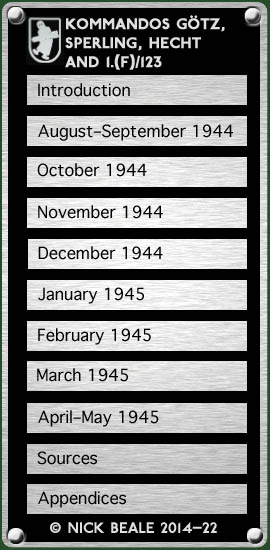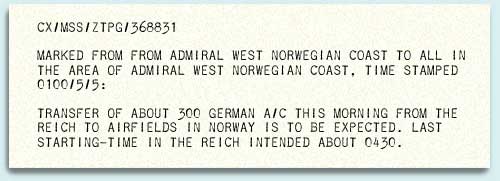|
Much more detail is available for the following days’ operations. Oblerleutnant Radau was in the air from 10.42–12.22 hrs. and was able to carry out part of the day’s task. His route was over Diepholz airfield – Osnabrück – Bielefeld – Hannover – Nienburg – Minden – Bad Oeynhausen – Osnabrück – Bramsche – Lübeck – Sulingen – Minden – Hameln – Elze. He flew between 8000 and 8500 m, relying entirely on his cameras and making no visual observations. Oberleutant Krüper too flew a purely photographic sortie, fulfilling the south eastern part of his assignment. Taking off at 11.32 hrs. he was in the air for 76 minutes, covering Celle airfield – Hannover – Hildesheim – Holzminden – Blomberg – Hameln – Springe – Hannover – Oldendorf – Lemgo (or Lemgow) – Hannover from 8000 m. Rough interpretation of these pilots’ photographs yielded a lengthy report that evening: several destroyed bridges were noted along with traffic movements, artillery positions, 800 rail wagons in the station at Minden, artillery spotting planes on landing grounds and so on. On the 9th the Staffel had 8 (4) aircraft and ULTRA revealed that Ar 234 W.Nr. 140153 was at Lübeck-Blankensee; its markings were not stated but if it was still +HH then it was unserviceable. Radio monitoring suggested a possible operation by the Staffel in the Bremen area at around 17.45 hours. According to British Intelligence, three of 1.(F)/123’s Arados carried out reconnaissance of the areas Bremen – Osnabrück – Paderborn – Kassel – Mühlhausen – Hannover on the 10th but no times could be attached to these flights. Next day later 14. Fliegerdiv. reported that an Me 262 and two Ar 234 had carried out photo-reconnaissance of “Bresendieck” [Bredenbeck?], Holzminden, Hannover, Hameln, Nienburg and Bremen. The Staffel’s reported strength on the evening of 12 April was 9 (3) aircraft and 10 (8) crews. The Fliegerdivision sent up two Ar 234 on 14 April which, together with a number of Me 262, were active over Ülzen – Bremen – Hannover – Brunswick – Magdeburg – Wittenberge. Radio traffic indicated at least one morning and two afternoon jet reconnaissance operations, with a further one over Rethem between 15.40 and 16.00 hours. None of these can be attributed to a particular unit. Horst Götz recalled that his final mission was flown on 14 April. The 15th brought radio traffic which came from a jet aircraft “of possibly 1.(F)/123” in the Parchim area between 20.00 and 21.00 hours. On 17 April Stab FAG 123 announced that was going off the air as it had been disbanded. The next two days’ radio traffic again showed signs of jet reconnaissance, including two apparent sorties by 1.(F)/123 on the 19th (from 06.29–07.25 and 16.58–17.39 hrs.). On the 20th a “possible jet recce” was overheard in the northern sector before 07.00 hours. On the 23rd the Rechlin research establishment was told that it should hand over Ar 234 W.Nr. 140105 to 1.(F)/123 which would collect the aircraft. Next day, the RAF photographed four Ar 234 in the NW remote dispersal at Lübeck-Blankensee. Whilst reconnaissance operations were detected over the British Second Army sector on 25 and 26 April but Bletchley’s Operational Watch could only state that jet aircraft were probably involved. On the former date, at 0915 GMT, a “possible Ar 234” was seen under tow at the western end of Hohn’s east-west runway. On 1 May, five of Fliegerdiv. 14’s reconnaissance aircraft operated before 14.00 hrs. These covered the Stade – Boizenburg sector and the Lauenburg bridgehead on the Elbe. The only individual report of results was timed at 16.00 hrs. and reported Allied tanks. On 2 May there was R/T evidence of two morning operations in the Stade – Hamburg area, one at midday west of Kiel and an evening one over the Lauenburg crossings. The next day the Allies overheard R/T from a “possible jet recce west and north west of Hamburg” from 13.45–14.15 hours. Pilot Officer Des Watkins of No. 350 (Belgian) Squadron was leading Pink Section — in Spitfire XIVs — on an armed reconnaissance of the Rendsburg area. At about 17.10 local time (15.10 GMT) they were at 8,000 ft (2500 m) when Watkins spotted a jet aircraft in the circuit at Hohn, identifying it as an Ar 234. All four Spitfires dived to attack, Watkins closing to 50 yards and opening fire with his machine guns, hitting the wings and fuselage leaving the Arado smoking. F/L Patrick Bangerter (Commander of A Flight):
Flight Sergeant André Kicq (Pink 2) and F/O Albert Van Eckhoudt (Pink 4) attacked together and saw strikes but broke away as they were overtaking too fast:
According to their joint combat report, the Spitfire pilots used cine guns during the attack. The Arado’s pilot, the 23 year-old Oblt. Fritz Worschech, did not survive the disintegration of his aircraft and is buried in the military cemetery at Fahrdorf, near Schleswig.
The 1.(F)/123 ended the war at Hohn but the schedules prepared for the British occupation forces give no figures for either aircraft or personnel with it at the time of the German surrender, although W.Nr. 140141 (4U+FH) and 140581 had been evacuated to Stavanger by this time:
A report to OKL on 22 May 1945 still listed Horst Götz as the Staffel’s Commanding Officer. He later told researchers that he had given his pilots permission to fly wherever they wished, just before the British took their airfield. His own Arado's nosegear had collapsed as he was about to take off and so the machine was blown up to prevent its capture.
|
||||




